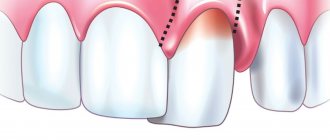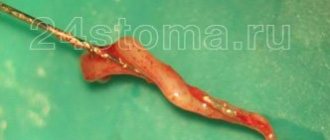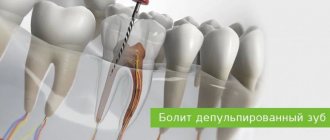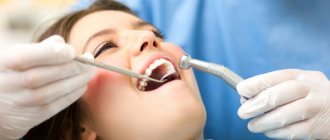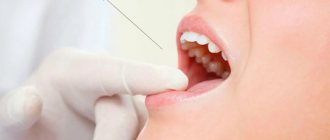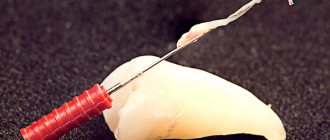Conservative method of treating pulpitis
The simplest option used by dentists for patients suffering from focal, acute and fibrous infections. It consists of carrying out a certain list of fairly easy and quick procedures:
- Anesthesia using local anesthetic drugs.
- Removing affected tissue using, for example, a drill.
- Treatment of the oral cavity with any specialized antiseptics.
- Applying an insulating pad.
- Installation of a temporary filling product.
The result of such operations is a whole range of positive aspects. The patient's severe inflammation is relieved, metabolic processes are restored, dentin regeneration begins, and so on.
Surgery
It is possible to understand what dental pulpitis is and how to treat the pathology in question, including through a detailed analysis of the techniques that require the use of any types of surgical interventions. The main indication for the use of such instructions is the presence in a person of a diffuse, focal and chronic inflammatory process of the fibrous and hypertrophic type. All activities are carried out according to strictly defined instructions:
- Anesthesia by introducing local, conduction anesthesia into the body.
- Isolate the affected area with sterile pads and pads.
- Opening the carious plane and treating the lesions with an antiseptic.
- Excision of the coronal part of the pulp extractor.
- Expanding the canals and treating them with antiseptic agents.
- Preliminary and final filling performed after x-rays.
It is not difficult to guess that only an experienced doctor with a variety of different skills can cope with a series of such procedures at the highest quality level. These are the specialists who work in dentistry.
Treatment of pulpitis with removal of the dental nerve
Another event characterized by a fairly high complexity. As a rule, all medical interventions are performed in two stages. During the first of them, the specialist:
- Removes the carious plane.
- Removes damaged tissue from the pulp itself.
- Treats the excision site with an antiseptic.
- Carrying out work on installing a temporary filling.
After approximately one to two weeks, the patient necessarily comes for the second session. As part of the additional (finishing) procedure, the following actions are carried out:
- Short-term filling is removed.
- Inspection and cleaning activities are carried out.
- The oral cavity is exposed to antiseptic agents.
- A permanent material is installed to fill the voids in the tooth process.
The main advantage of all processes is the possibility of preserving a healthy dental element. In addition, the person subsequently feels positive effects due to the regeneration of vitality and sensitivity of the pulp itself.
Treatment of pulpitis of a multi-rooted tooth
A devital technique, in which the doctor initially kills the problem area using a special necrotizing paste. In the past, doctors involved in such work used ordinary arsenic, placed in the carious plane for several days.
Today, modern medicine has stepped forward, providing craftsmen with a much wider range of tools. Dental staff use the most gentle drugs that do not kill nerve tissue in the oral cavity. It is not difficult to guess that the use of such substances is a completely safe operation.
Extirpation of pulpitis
Probably the most radical treatment method, which includes a whole complex of processes to remove the inflamed neurovascular bundle, followed by sanitation and filling. The doctor can undertake its implementation only in the case when any other methods of therapy clearly do not lead to success. As in previous cases, the procedure is carried out in a vital and non-vital format: under the influence of local anesthesia or using a necrotizing paste-like drug. Depending on how complex the disease is, the specialist may need from 3 to 4 sessions, the result of which, of course, will be a complete cure of the patient from the specified range of problems.
Symptoms of tooth pulpitis
How can you determine that your tooth hurts precisely because of the development of pulpitis? This disease has its own characteristic symptoms and the first sign of the development of pulpitis may be pain that occurs when a diseased tooth comes into contact with cold/hot, sweet/sour foods. Unlike pain during caries, these sensations do not go away immediately after the irritant that caused them is eliminated: they persist for longer than 15 minutes. If you are bothered by such sensations during and after eating, you need to urgently contact your dentist for diagnosis and treatment of pulpitis.
It is important to understand that without proper treatment, pulpitis will not go away: the inflammatory process will continue to develop and this will lead to the transition of pulpitis to an acute form. In acute pulpitis, pain can occur suddenly and on its own, without external influence. Pus collects in the pulp, and if there is no natural outlet for its outflow, it begins to put pressure on the bundle of nerves, and severe pain occurs.
At first, this pain can be eliminated by taking tablets from the pharmacy, but if treatment for pulpitis is not carried out, pharmacy painkillers will no longer help. The pain will be excruciating and constant, moreover, it can spread along the nerve endings to different parts of the oral cavity. For this reason, people who go to the doctor for treatment of acute pulpitis often cannot pinpoint exactly which tooth is hurting. In acute pulpitis, swelling of the gums and increased body temperature may be observed.
Pulpitis is not only acute - it has its own fairly extensive classification into various forms, and each form of pulpitis has its own symptoms. Accurate determination of the form of pulpitis is of fundamental importance for choosing an effective method of treating it. Below we will look at all seven main forms of pulpitis and their main symptoms.
Fibrous pulpitis of the tooth
The development of a fibrous form of pulpitis may be indicated by mild, aching pain, which occurs most often when a tooth comes into contact with hot/cold food during chewing. The pain is usually localized quite clearly - in one tooth. If fibrous pulpitis is not treated in time, then as the disease develops, pain may appear on its own and not stop for 24-48 hours.
Hypertrophic form of pulpitis
With this form of pulpitis, patients who go to the doctor for treatment complain of a viscous, aching pain, which often occurs when eating. This pain causes people to avoid chewing on the side of the jaw where the painful tooth is located. Another sign of hypertrophic pulpitis may be bleeding gums that appear when brushing teeth in the area of inflammation.
Gangrenous pulpitis and its symptoms
This form of pulpitis is also characterized by aching pain that occurs under the influence of chewing load on the teeth or from contact of the diseased tooth with temperature irritants. A person with the development of gangrenous pulpitis may experience the appearance of extremely unpleasant odor from the mouth, which cannot be removed by the standard procedure of brushing teeth and rinsing with balms. When, when treating gangrenous pulpitis, the dentist opens the tooth cavity, thick gray pus with a fetid odor is found in the area of inflammation.
Chronic pulpitis and signs indicating its development
This form of pulpitis is insidious in that it may not show itself for a long time.
Chronic pulpitis can be detected only after diagnostic measures are carried out or when it transforms into an acute form, which has bright and pronounced symptoms. Acute pulpitis, which has not been treated, can become chronic. But you shouldn’t think that you can continue to calmly live with a bad tooth and not take any measures to treat it. Chronic pulpitis sooner or later turns into acute and then a person is simply forced to see a doctor, because the pain becomes unbearable and pills from the pharmacy cannot save it.
To choose an effective treatment method, you need to conduct a high-quality diagnosis that allows you to determine the form of pulpitis and the stage of development of inflammation.
Other treatments
In 2022, there are additional ways for doctors to save people from troubles associated with pulp inflammation:
- laser therapy;
- complex of physiotherapeutic processes.
Both mentioned operations, in principle, can also answer the question of how to cure pulpitis without removing the nerve. True, they can only be used in the early stages, when the pathology has not yet had time to develop and acquire serious symptoms. In addition, to use such funds, a person will need to go to a truly modern and advanced clinic with an experienced medical team. For example, a set of works related to the use of a laser is carried out exclusively in the presence of high-quality, proven equipment. Such installations, of course, are present in dental departments.
Anesthesia
Almost always, the nerve is removed under local anesthesia; usually, instead of the upcoming operation, the required dose of the drug is administered using a syringe. Immediately before the injection, the gums are treated with a special spray or gel containing an anesthetic, so even the slightest discomfort is eliminated. The needles used are as thin as possible.
There are several of the most common drugs used by dentists for pain relief: mepivacaine, ultracaine, articaine with epinephrine or pure. These products prevent the onset of pain; they are suitable even for people with chronic diseases, pregnant women and those prone to allergic reactions.
A gel with lidocaine is also actively used, which is placed around the diseased tooth. In this case, the patient feels as relaxed as possible and does not have any unpleasant sensations. In rare cases, pain may occur due to an incorrectly administered drug or due to the individual reaction of the patient's body. If you have a strong fear of dentists or serious psychological disorders, nerve removal can be performed under general anesthesia.
Is it possible to cure pulpitis and how are nerves removed: types of anesthesia
As mentioned earlier, pulp inflammation is an extremely painful pathology, which primarily affects the nerve endings inside the oral cavity. The process of its treatment necessarily includes an operation to select a high-quality antiseptic that is suitable for a particular person. Moreover, the drug is applied to the desired places using various methods:
- application;
- infiltration;
- conductive;
- stem
The anesthetics used are traditional pairs of lidocaine and novocaine, as well as more advanced and modern formulations: Ultracaine, Ubistezin, Septanest, and so on.
When is it necessary to remove a nerve in a carious tooth?
If you delay visiting the dentist, caries can develop into serious inflammation of the pulp.
Bacteria destroy all tooth tissues, their integrity is disrupted, and the process reaches the pulp chamber, that is, the nerve. This disease is called pulpitis. When severe sharp or aching pain in a tooth appears, you should immediately consult a dentist. Without receiving timely treatment, the tooth will have to be removed. But if treatment is started on time, the nerve is necessarily removed, and the tooth is preserved and continues to perform its function.
In dental practice, there are known cases of traumatic pulpitis, the occurrence of which is influenced by a blow during an attack or accident. Typically, the frontal row of teeth suffers from such pulpitis.
Another cause of pulpitis is calculi, that is, dense deposits that appear in the dental canals due to metabolic disorders.
Stages of treatment
Most of the operations, the main task of which is to heal the inflamed pulp, can be divided into a list of conditional stages:
- Excision of dental tissue.
- Extraction of the neurovascular bundle itself.
- Channel cleaning.
- Filling.
The question of how pulpitis is treated in 2 visits with the removal of teeth and nerves can clearly be answered by any more or less qualified dental specialist. However, not everyone, even experienced doctors, had to deal with the most severe forms of this disease. It is not difficult to guess that the key to the success of the entire therapy as a whole is a visit to a specialized specialist who knows how to handle modern equipment and the advanced range of today’s pharmacological drugs. Such professionals, of course, include dental staff.
How long does pulp removal take?
On average, it takes about 40-50 minutes for pain relief, nerve removal, and root canal treatment. If the doctor administers high-quality anesthesia, it will take effect almost immediately, and the patient will not feel pain throughout the entire process. If the effect of anesthesia weakens during depulpation, an additional injection is given.
Reference! Before administering an injection with anesthesia, the doctor treats the soft tissue with a special freezing agent. That is, the patient will not experience pain either when inserting a needle into the tissue or during the process of removing the dental nerve.
Is it painful to treat pulpitis?
Inflammation of the pulp is a disease characterized by pronounced, extremely acute symptoms, mainly in terms of pain. Almost any manipulation with a damaged element of the oral cavity causes severe discomfort to patients in medical clinics. However, such a problem can be resolved quite simply - a good dentist will easily select a high-quality, suitable anesthetic agent. That is why the process of surgical intervention itself, as a rule, takes place without third-party excesses. Much more unpleasant sensations await people who refuse to visit a doctor in a timely manner.
Does it hurt or not?
Since the pulp consists of more than 20% nerve endings, it is very sensitive to even light touches. That is why a disease such as pulpitis (inflammation of nerve endings) is always accompanied by severe pain. As a result, the tooth becomes very sensitive to any kind of irritant.
Because of this, any interventions and nerve removal are carried out only under local anesthesia. Otherwise, the patient simply will not be able to tolerate the discomfort. Today it is customary to distinguish two groups of indications for surgery to remove tooth nerves: therapeutic and orthopedic. Therapeutic ones assume the presence of pathology in the pulp, for example, developing deep caries, inflammatory processes in the root of the tooth (periodontitis), damage to deep tissues by stones, severe injuries to the jaw, etc.
In addition, dentists often talk about the need for pulp removal before upcoming orthodontic treatment, installation of crowns or dentures. Orthopedic indications include the presence of a risk of developing inflammation in the pulp chamber, severe curvature or tilt of the tooth, which does not make it possible to grind the crown, low coronal part, etc. In all these cases, removal of the nerve is a mandatory procedure before starting treatment, but the final decision is always made by the attending physician.
Canal filling
This stage in the treatment of pulpitis is carried out during the next visit to the dentist’s office. Filling of the canals can be carried out either with or without an anesthetic injection. The second option is preferable, since slight pain during the process is a sure signal to the doctor that the pin with gutta-percha has reached the upper part of the tooth root, and therefore the filling depth needs to be changed.
The procedure begins by removing the temporary filling and washing the canals with an antibacterial solution. Then they are filled as tightly as possible with gutta-percha and sealer, which are placed into the canal with pins. After completion of the manipulations, a control x-ray is taken.
Constant radiological monitoring in the treatment of pulpitis is mandatory; it allows the procedure to be carried out with a minimum of errors and at the proper level of quality. If the image shows that the canal is sealed poorly, the materials embedded in it are removed and the procedure is repeated from the very beginning. This stage of pulpitis treatment ends with placing a temporary filling on the tooth and advising the patient on how to care for the oral cavity during the healing period.
Calculate the cost of treatment by taking a short test in 20 seconds!
Do not delay your treatment, because in this matter time plays against us.
Pulp extraction
Before removing pulp from the coronal area of the tooth, as well as from the dental canals, the manipulation area must be carefully isolated from moisture. This is done so that pathogenic microflora does not enter the canals along with saliva. For high-quality tooth isolation, a specialized latex rubber dam is used.
The process of pulp extraction itself is carried out with a special tool, on which the pulp is wound and then pulled out. Next, the doctor proceeds to a particularly important point in the treatment of pulpitis - measuring the length of the tooth canals. Measurements must be carried out with maximum accuracy, since errors in them are fraught with the following negative consequences:
• The canals will be unfilled, which can provoke various complications after treatment of pulpitis; • The canals will be refilled and excess material in them will cause pain and can even lead to trauma to the nervous tissue of the lower jaw.
To obtain accurate data on the length of the root canals, the patient is prescribed an X-ray examination, and the specialist also uses a special type of device, an apex locator. This device is equipped with K-files that are inserted into the canal stoma, and the specialist will advance them in depth until the apex locator monitor receives an alert that the instrument has reached the top of the tooth root.
An apex locator measures the length of each root, since they are unique both in this indicator and in structure. The data obtained during the measurements are recorded, but the procedure does not end there: at the next stage, the doctor enters K-files into all canals at once and takes a control image necessary to obtain the most accurate picture of the depth of the roots.
Introduction of an anesthetic drug
It is impossible to do without anesthesia when treating pulpitis. When the pulp is damaged, the nervous tissue becomes inflamed and therefore any therapeutic manipulations will be unbearably painful for the patient. Therefore, before starting treatment of pulpitis, the doctor will administer an anesthetic, the action of which will remove the pain for the time necessary for carrying out therapeutic actions.
Sometimes, even after the administration of pain medication, the patient may feel pain. This suggests that either the amount of the drug was calculated incorrectly, or that the doctor made a mistake when giving the injection. Do you want to cure pulpitis painlessly and efficiently? Contact the specialists of the Vanstom dental clinic in Moscow! Our dentistry works for you at the address: Moscow, Baumanskaya metro station, st. Bakuninskaya, 17/28.
Primary canal treatment and installation of a temporary filling
High-quality treatment of tooth pulpitis involves preliminary mechanical expansion of the root canals and their subsequent filling, first temporary and then permanent. The channels are also expanded with a special tool using K-files or reamers. In order to make the necessary expansion, the doctor carefully rotates the K-file and its cutting edges remove chips from the canal walls. It is necessary to increase the size of the canal manually in order to subsequently perform a high-quality filling.
All canals are processed in a similar way to the depth determined by the apex locator and control radiography. During the mechanical treatment, the canals are also constantly washed with antiseptic agents to eliminate the risk of infection entering the root part of the tooth, as well as to eliminate chips removed by manipulation.
After the channels are properly expanded, they are thoroughly washed again, dried, and pads impregnated with an antiseptic drug are placed in them. A temporary filling is placed on the tooth.
Are folk remedies effective in treating pulpitis?
Out of fear of dentists, some patients make the serious mistake of trying to cure pulpitis on their own and use all kinds of remedies from the collection of folk recipes, all kinds of decoctions, compresses, and tinctures. Let’s say right away that traditional medicine is absolutely useless in the treatment of pulpitis. And in some cases, its use can provoke severe complications.
Inflammation of the pulp is almost always observed against the background of advanced caries. From the tissues affected by it, bacteria gradually penetrate into the pulp chamber and in order to cure pulpitis qualitatively, all layers of enamel and dentin with carious damage should be eliminated. This can be done only in one way - by drilling with a special tool, which is in the arsenal of modern dentistry.
Even worse are those patients who, having read “grandmother’s recipes,” begin to warm up the area of inflammation. Apply warm compresses or even just heating pads to the tooth. But you should know that heating in the case of an active inflammatory process can worsen the situation, but in no way alleviate the patient’s condition! Warming up catalyzes the spread of inflammation and can cause the onset of purulent pulpitis.
In addition, one should take into account the fact that bacteria that provoke inflammation of the pulp are extremely resistant to even the most potent antibiotics. The drugs will not help either slow down the inflammatory process or relieve acute and painful pain. From here we can draw a simple conclusion: it is possible to cure pulpitis only in the dentist’s office. And the sooner you contact a specialist, the higher the chances will be that you can do without pulp removal and preserve the dental nerve.
Do you want to receive high-quality pulpitis treatment services? Contact our dental clinic in Moscow “Vanstom”! In our dentistry you will find: modern materials and equipment, innovative treatment methods, sensitivity and professionalism of doctors, reasonable prices for the entire range of dental services. To make an appointment at Vanstom, just dial our contact phone number!
Causes
The main cause of pulpitis is advanced caries, when the teeth are so destroyed that the infection penetrates the tooth cavity and affects the nerve.
Pulpitis can develop as a result of tooth trauma (chipping, blow), chemical or temperature exposure. Sometimes pulpitis develops due to a poorly placed filling, rough grinding of teeth or other unprofessional actions of dentists, but in our clinic such situations are excluded due to the high qualifications and responsibility of the staff. Also, the cause of pulpitis may be associated with the spread of infection through the hematogenous route (through the bloodstream) in some diseases. Complications during the treatment of caries can also provoke pulpitis.
Why does pulpitis begin?
- The most common cause of pulpitis is untreated caries. The carious process worsens, the carious cavity deepens, and eventually the pulp chamber, which contains the “nerve,” is destroyed. Bacteria from the carious cavity enter and infect the pulp - inflammation begins.
Also, the cause of pulp inflammation can be:
- Mechanical damage to the pulp as a consequence of trauma.
- A complication after inaccurate tooth preparation during various dental procedures.
Feel
After full anesthesia, dental treatment and accompanying manipulations are absolutely painless. The patient does not even notice the nerve removal procedure. Some patients experience discomfort as the anesthesia wears off. There may be increased tooth sensitivity when biting. This is a normal reaction to canal work, does not cause much discomfort, and usually goes away after a few days. Taking painkillers eliminates these sensations.
Be healthy!
The information was prepared by dentist Smirnov E.S.
